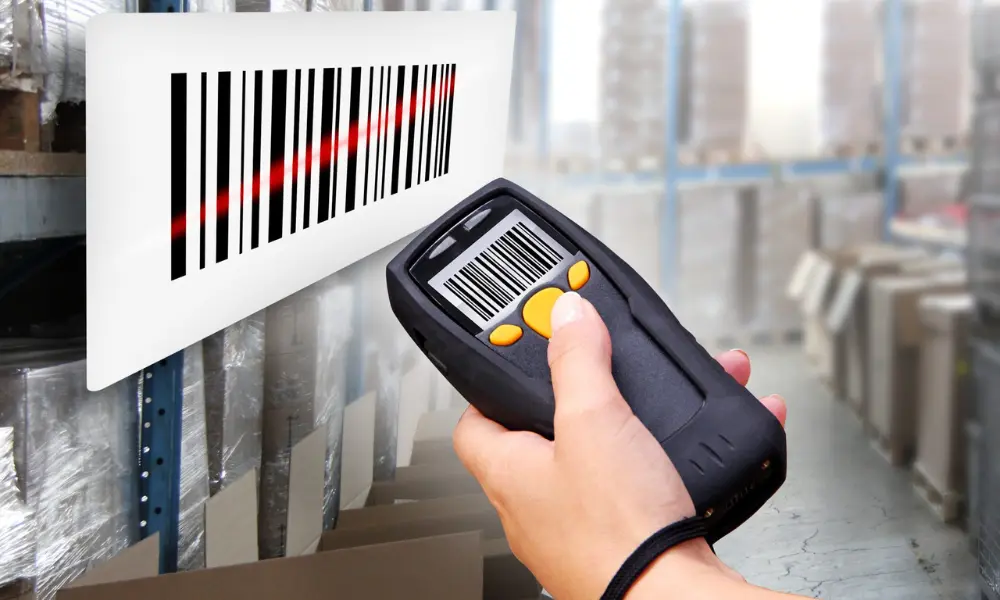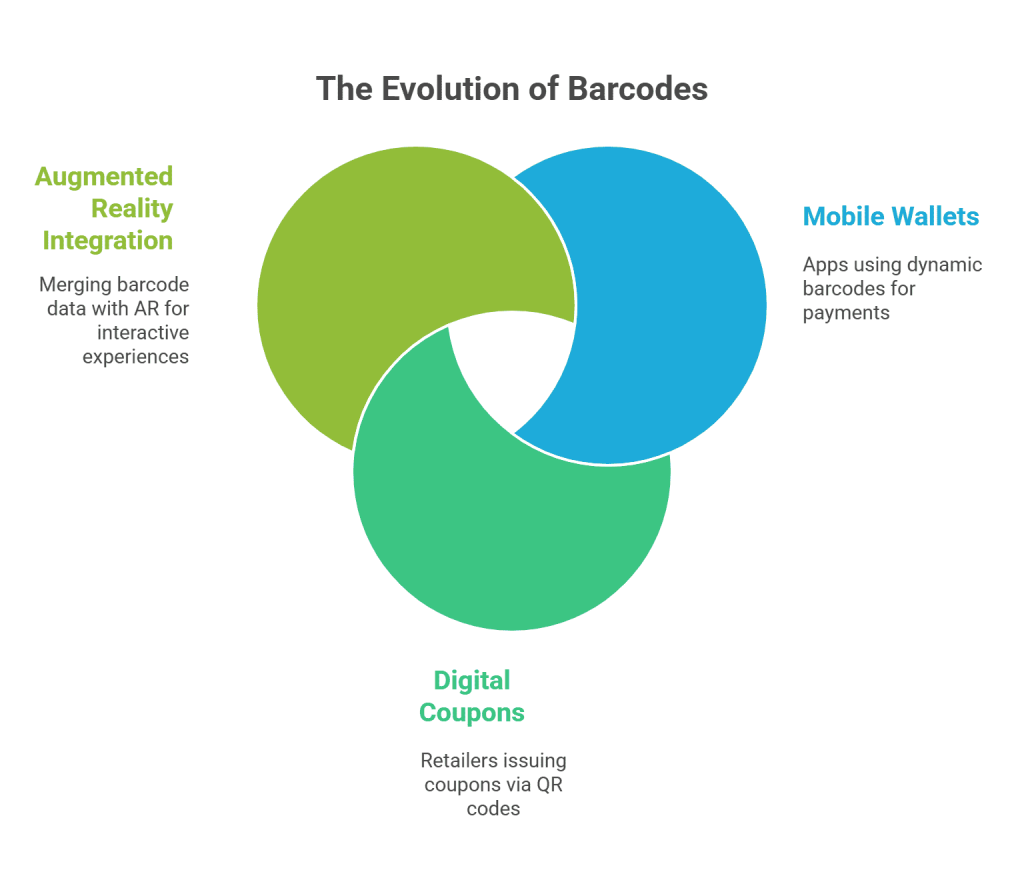Barcodes have long been the silent workhorses behind global commerce, inventory control, and supply chain management. From the black-and-white lines of the classic UPC symbol to the complex patterns of today’s 2D codes, the evolution of barcodes mirrors the digital transformation sweeping through every industry. But how did we get here, and where are we heading?
This blog takes you on a deep dive into barcodes, exploring their origins, limitations of linear systems, and the cutting-edge technologies that are redefining what barcodes can do.

Barcode Changes: A Response to Manual Inefficiency
The story of the evolution of barcodes begins in 1949, when Norman Joseph Woodland and Bernard Silver developed a system inspired by Morse code to help automate checkout counters. The original concept was a bullseye-style circular code, which eventually evolved into the first linear barcode.
In 1974, the Universal Product Code (UPC) became the first barcode used commercially, scanned on a pack of Wrigley’s chewing gum. The linear barcode, comprising a series of black lines and white spaces, was a revolutionary leap for retail and logistics. It eliminated the need for manual entry, dramatically reducing errors and speeding up transactions.
However, linear barcodes came with limitations. They could store only a limited amount of information (typically 8–15 characters) and required precise scanning angles and close proximity.
Upgrading of 2D Barcodes: Data Expansion in a Small Space
As industries demanded more data to be embedded into barcodes—batch numbers, expiry dates, serial numbers—the limitations of linear barcodes became evident. This led to a significant turning point in the evolution of barcodes: the introduction of 2D barcodes.
2D barcodes, such as QR (Quick Response) codes and Data Matrix codes, do not rely solely on horizontal lines. Instead, they store data both horizontally and vertically, enabling them to hold thousands of characters, including binary data and URLs.
- QR Codes: Originally developed in 1994 by Denso Wave, QR codes became popular due to their high data capacity and fast readability. They found wide adoption not only in industrial applications but also in consumer interactions like mobile payments, ticketing, and advertising.
- Data Matrix: Widely used in pharmaceuticals and electronics, these codes are ideal for labelling small items due to their ability to be read even when partially damaged.
The barcode evolution at this stage was more than cosmetic; it transformed them into data-rich, multi-dimensional tools that could be scanned from any angle and required much less space.
Beyond Black and White: Colour Barcodes and Augmented Codes
Another change in barcode came with the introduction of colour. While conventional scanners are designed to read black-and-white patterns, newer technologies are capable of interpreting color barcodes that significantly expand data storage without increasing the physical size of the code.
- Color QR Codes: By assigning meaning to different color channels (Red, Green, Blue), color barcodes can store three times as much data in the same space.
- High Capacity Color Barcode (HCCB): Developed by Microsoft, HCCB uses colored triangles instead of black-and-white lines. Though not widely adopted, it showed how visual design could enhance functionality.
Color-based coding, although not yet mainstream due to the need for advanced scanners, is a promising frontier in the evolution of barcodes, especially as camera technology improves.
Barcodes Meet the Internet of Things (IoT)
In modern supply chains and smart factories, barcode types are no longer passive identifiers; they are part of interconnected systems that respond in real-time. Barcodes have enabled deeper integration with IoT platforms, allowing for smarter asset tracking, predictive maintenance, and seamless inventory updates.
For example:
When a barcode on a pallet is scanned, the data can automatically update cloud-based inventory systems. In healthcare, barcode wristbands on patients sync with medical databases to reduce medication errors.
The convergence of barcoding and IoT is transforming how we view automation and traceability, making the evolution of barcodes central to Industry 4.0.
From Physical to Digital: Virtual Barcodes and Mobile Scanning

As smartphones became ubiquitous, so did the ability to scan barcodes without dedicated hardware. This has had a profound impact on the evolution of barcodes, particularly in eCommerce, payments, and contactless experiences.
1. Mobile Wallets:
Apps like Apple Wallet and Google Pay use dynamic barcodes for payments and ticketing.
2. Digital Coupons:
Retailers now issue coupons via QR codes that are scanned at POS systems.
3. Augmented Reality Integration:
Some applications are merging barcode data with AR to provide interactive product details or instructions.
The shift to mobile and digital formats has decentralized the scanning process, empowering both businesses and consumers.
The Future: Blockchain, Security, and Intelligent Codes
Looking ahead, barcodes are poised to take another leap—one that prioritises data integrity, traceability, and real-time validation. The next barcode-based upgrade will be Blockchain. These will record the entire journey of a product, from origin to end-user, creating immutable records for audits and recalls.
Intelligent barcodes powered by AI and computer vision are also emerging. These systems can:
- Detect counterfeit products
- Automate expiry and batch tracking
- Alert users if product data has been tampered with
With security and transparency becoming top priorities in global trade, the evolution of barcodes is heading toward systems that are not just scannable but also verifiable.
FAQs – Evolution of Barcodes
1. What is the main reason behind the growth of barcodes?
The primary reason is the growing need for storing and accessing more complex information in smaller, more accessible formats. From simple retail tracking to real-time data integration, barcodes have evolved to meet increasing data and automation demands.
2. How do 2D barcodes differ from traditional linear barcodes?
2D barcodes store data in both horizontal and vertical directions, allowing them to hold significantly more information. They are also more durable and can be scanned from various angles.
3. Can smartphones scan all types of barcodes?
Most smartphones can scan both linear and QR codes using their built-in cameras. However, reading specialised codes like Data Matrix or colour barcodes may require specific apps or hardware.
4. What industries benefit the most from the evolution of barcodes?
Retail, logistics, healthcare, manufacturing, and pharmaceuticals are some of the biggest beneficiaries. Each industry uses advanced barcoding for better traceability, accuracy, and automation.
5. What role do barcodes play in the Internet of Things (IoT)?
Barcodes act as data entry points in IoT ecosystems. When scanned, they can trigger system updates, alerts, and process automation, making them integral to smart operations.
6. Are color barcodes widely used today?
Not yet. Colour barcodes are still in the experimental or specialised-use phase due to hardware limitations. However, they represent a promising future in data-dense environments.
7. Is blockchain integration with barcodes already in use?
Yes, especially in high-risk industries like food and pharmaceuticals, where traceability and data security are critical. Blockchain ensures a tamper-proof history for every scanned item.
Conclusion
The evolution of barcodes is more than a tale of technological progression—it’s a story of adapting to an increasingly data-driven world. From simple black lines to intelligent, color-rich, blockchain-integrated systems, barcodes have come a long way. And with innovations like AI, IoT, and AR pushing boundaries further, they will remain a foundational element in the seamless exchange of information across industries.
As we move beyond linear codes, barcodes continue to prove that even the most familiar technologies can transform into powerful tools of the future. Explore advanced scanning technologies to automate logistics. Contact Qodenext today.






